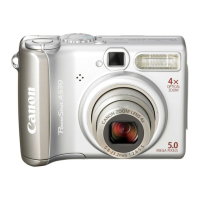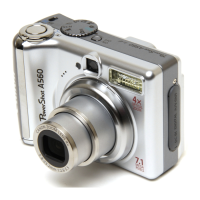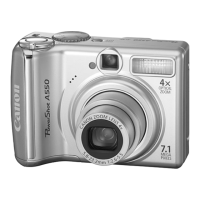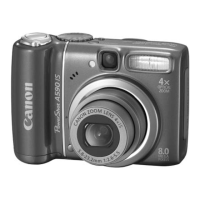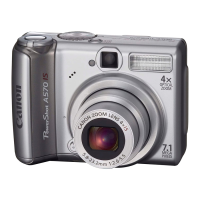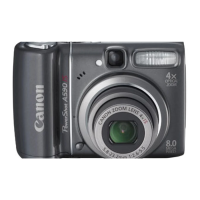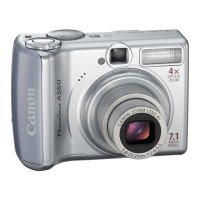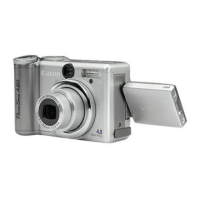Do you have a question about the Canon PowerShot A510 and is the answer not in the manual?
Legal notice regarding accuracy, liability, and reproduction rights.
Lists registered trademarks and company acknowledgements.
Visual guide to manual sections and cross-references.
Explanation of icons and marks used throughout the manual.
Important introductory notes, safety, and malfunction prevention.
Identification and description of camera parts and terminals.
Instructions for installing batteries, memory cards, and setting up the camera.
Core operations like power control and mode switching.
Using the camera in fully automatic shooting mode.
Tips and methods for composing shots using the optical viewfinder.
How to view and interact with images immediately after capture.
Overview of scene modes for automatic shooting adjustments.
Adjusting image quality settings for different purposes.
Guide to selecting and using different flash modes.
Instructions for close-up photography using macro mode.
How to use the self-timer for delayed shots.
Using digital zoom to magnify subjects beyond optical limits.
Capturing a rapid sequence of shots.
Guide to taking photos for creating panoramic images.
Using specific scene modes for optimized shooting conditions.
Mode for shooting images optimized for postcard printing.
Instructions for shooting video clips with sound.
Navigating camera menus and adjusting various settings via FUNC/MENU.
Overview of menu items and their default configurations.
Control over exposure settings like shutter speed and aperture.
Using program auto-exposure for balanced scene brightness.
Adjusting shutter speed in priority modes for motion control.
Adjusting aperture in priority modes for depth of field control.
Full manual control over exposure settings.
Changing autofocus frame selection methods.
Selecting how the camera measures light for exposure.
How to compensate exposure for better image brightness.
Setting white balance to match lighting conditions for accurate colors.
Adjusting light sensitivity for different shooting conditions.
Applying creative color and contrast effects to images.
Controlling the intensity of the flash in manual mode.
Techniques for focusing on challenging subjects.
How to manually set the camera's focus.
Enabling automatic image rotation based on camera orientation.
Viewing recorded images one by one on the LCD.
Zooming in on images for detailed viewing.
Displaying multiple images simultaneously in a grid.
Quickly navigating through images in index playback.
How to play back recorded movie clips.
Trimming unwanted parts from movie clips.
Rotating images 90° or 270° clockwise.
Adding short audio recordings to still images.
Automatically playing back all images on the memory card.
Preventing accidental erasure of important photos and movies.
Methods for printing images directly or via photo services.
Selecting images and specifying print quantities in advance.
Transferring images from camera to computer via USB or card reader.
System requirements and procedures for computer connection.
Connecting the camera to a TV for image viewing.
Configuring how image file numbers are assigned.
Personalizing camera startup images, sounds, and themes.
Saving custom settings like startup images and sounds.
Solutions for when the camera fails to power on or function.
Troubleshooting steps for issues with image recording.
Solutions for problems viewing recorded images.
Addressing issues with rapid battery drain.
Diagnosing and fixing blurry or unfocused images.
Solutions for images appearing too dark due to lighting.
Solutions for images appearing too bright due to lighting.
Information on using optional power accessories like battery chargers.
Details on compatible lens converters and adapters.
Guide to replacing the camera's internal date/time backup battery.
Procedures for cleaning and maintaining the camera body and lens.
Technical details of the camera's hardware and features.
Expected number of shots and playback time with different batteries.
Recordable images for different card types and resolutions.
Chart showing function availability across different shooting modes.
Advice on using the self-timer to avoid camera shake.
Tips for creative macro photography using zoom.
Manual adjustments for image brightness when auto-exposure is suboptimal.
How to correct images that are too dark or too bright.
Legal notice regarding accuracy, liability, and reproduction rights.
Lists registered trademarks and company acknowledgements.
Visual guide to manual sections and cross-references.
Explanation of icons and marks used throughout the manual.
Important introductory notes, safety, and malfunction prevention.
Identification and description of camera parts and terminals.
Instructions for installing batteries, memory cards, and setting up the camera.
Core operations like power control and mode switching.
Using the camera in fully automatic shooting mode.
Tips and methods for composing shots using the optical viewfinder.
How to view and interact with images immediately after capture.
Overview of scene modes for automatic shooting adjustments.
Adjusting image quality settings for different purposes.
Guide to selecting and using different flash modes.
Instructions for close-up photography using macro mode.
How to use the self-timer for delayed shots.
Using digital zoom to magnify subjects beyond optical limits.
Capturing a rapid sequence of shots.
Guide to taking photos for creating panoramic images.
Using specific scene modes for optimized shooting conditions.
Mode for shooting images optimized for postcard printing.
Instructions for shooting video clips with sound.
Navigating camera menus and adjusting various settings via FUNC/MENU.
Overview of menu items and their default configurations.
Control over exposure settings like shutter speed and aperture.
Using program auto-exposure for balanced scene brightness.
Adjusting shutter speed in priority modes for motion control.
Adjusting aperture in priority modes for depth of field control.
Full manual control over exposure settings.
Changing autofocus frame selection methods.
Selecting how the camera measures light for exposure.
How to compensate exposure for better image brightness.
Setting white balance to match lighting conditions for accurate colors.
Adjusting light sensitivity for different shooting conditions.
Applying creative color and contrast effects to images.
Controlling the intensity of the flash in manual mode.
Techniques for focusing on challenging subjects.
How to manually set the camera's focus.
Enabling automatic image rotation based on camera orientation.
Viewing recorded images one by one on the LCD.
Zooming in on images for detailed viewing.
Displaying multiple images simultaneously in a grid.
Quickly navigating through images in index playback.
How to play back recorded movie clips.
Trimming unwanted parts from movie clips.
Rotating images 90° or 270° clockwise.
Adding short audio recordings to still images.
Automatically playing back all images on the memory card.
Preventing accidental erasure of important photos and movies.
Methods for printing images directly or via photo services.
Selecting images and specifying print quantities in advance.
Transferring images from camera to computer via USB or card reader.
System requirements and procedures for computer connection.
Connecting the camera to a TV for image viewing.
Configuring how image file numbers are assigned.
Personalizing camera startup images, sounds, and themes.
Saving custom settings like startup images and sounds.
Solutions for when the camera fails to power on or function.
Troubleshooting steps for issues with image recording.
Solutions for problems viewing recorded images.
Addressing issues with rapid battery drain.
Diagnosing and fixing blurry or unfocused images.
Solutions for images appearing too dark due to lighting.
Solutions for images appearing too bright due to lighting.
Information on using optional power accessories like battery chargers.
Details on compatible lens converters and adapters.
Guide to replacing the camera's internal date/time backup battery.
Procedures for cleaning and maintaining the camera body and lens.
Technical details of the camera's hardware and features.
Expected number of shots and playback time with different batteries.
Recordable images for different card types and resolutions.
Chart showing function availability across different shooting modes.
Advice on using the self-timer to avoid camera shake.
Tips for creative macro photography using zoom.
Manual adjustments for image brightness when auto-exposure is suboptimal.
How to correct images that are too dark or too bright.
| Megapixel | 3.2 MP |
|---|---|
| Sensor type | CCD |
| Image sensor size | 1/2.5 \ |
| Digital zoom | 3.2 x |
| Optical zoom | 4 x |
| Display diagonal | 1.8 \ |
| Digital SLR | No |
| Dimensions (WxDxH) | 90.7 x 64 x 38.4 mm |
| Battery technology | Nickel-Metal Hydride (NiMH) |
| ISO sensitivity | 50, 100, 200, 400, AUTO |
| Shooting modes | Auto, Manual, Movie |
| Operating temperature (T-T) | 0 - 40 °C |
| Operating relative humidity (H-H) | 10 - 90 % |
| Flash modes | Red-eye reduction |
| Weight | 180 g |
|---|

